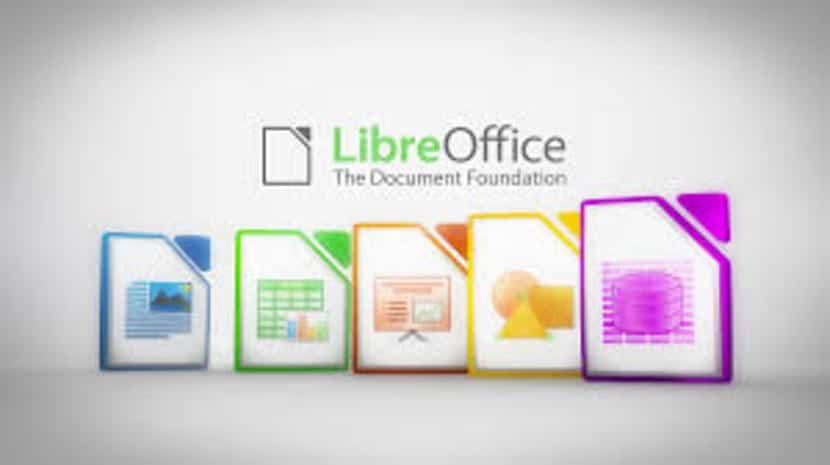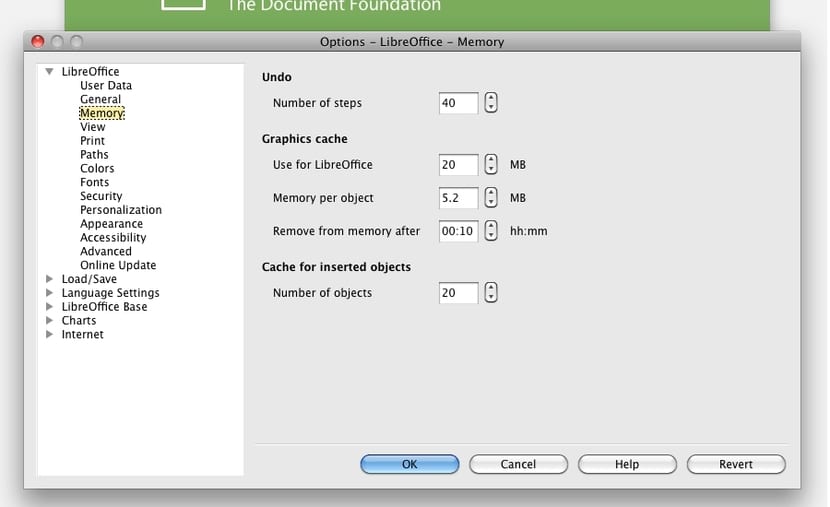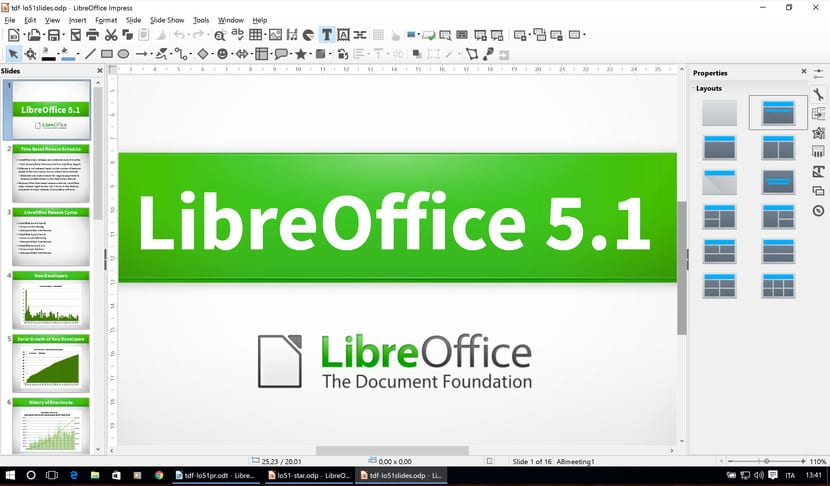
LibreOffice has become the office suite most important in the free software landscape, with important advances since it began as a fork of OpenOffice after the movements of Oracle after the purchase of Sun Microsystems. Lately they are enhancing one of their weak points, the graphical interface that is still far from perfect and is presented as one of the biggest problems when it comes to facing Microsoft Office.
Despite this, it is compatible with multitude of formats, both native to Microsoft Office and the open formats themselves, which are the natives with which LibreOffice and other free office suites work. In addition, the possibilities in terms of functions of this suite and that of Microsoft are equivalent and the same work can be done. I insist, making self-criticism, there are still some details to touch up and improve, but it is one of the best alternatives that exist.

But no software or operating system is good in the hands of someone who cannot take advantage of its capabilities, since you will be wasting the potential. Therefore, in this article we are going to give a series of tricks for the LibreOffice suite that will change the way you work with it, making its use more pleasant, simple, productive and efficient, which after all is what all users are looking for, in addition to taking advantage of its functionalities.
And what I have said in the previous paragraph is very important, since many of the complaints or disappointments that users take when landing in LibreOffice and that they come from Microsoft Office they are basically reduced to not knowing how to use or take advantage of the qualities of LibreOffice as they were doing in MS Office, making them crazy and making them go back to the Redmond suite. But if you know how to master it and get used to it, you may not miss commercial software.
Tips for LibreOffice

Many tips and tricks that exist on the net for LibreOffice are mostly intended to improve its performance, but in this megapost we do not want to focus only on the performance tricks, but be somewhat more generic and cover other points that allow us to improve in our daily use when we work with office documents and provide agility.
Tips and tricks to improve LibreOffice performance

So that our LibreOffice be something faster, avoiding wasting valuable seconds that can add to our work time to increase productivity and efficiency, we can make some adjustments in the suite. If you open any of the programs integrated in the office suite, such as LibreOffice Writer, you can go to the Tools tab on the top menu and then click on Options.
On the right you will see that there are several items to select, within LibreOffice you will see an option called Memory. We are shown a series of memory related settings. What we should touch is:
- Reduce Number of steps in the Undo parameter. This reduces the number of times you can hit the undo button to go back to the modifications you make in the text sheet. The higher this number is, the more flexibility it will allow you when it comes to going back, but the more memory it will occupy by having to store more steps ...
- La Image Cache is another important part. You can set 256MB maximum if you don't use too many images in your text sheet, but if you use a lot, you may want to leave more. And if you only use it for text, you can lower it to the minimum to save memory.
- Object Memory, you can set it to about 50MB. In this case, if your documents are not very "multimedia" you can download it without fear, since this space is reserved to handle elements that are not text or image, such as graphics, audio, etc.
- Si we set the image cache memory after 00:05 min, time. I insist, all this will depend on the amount of memory you have in your system and the uses that you give to LibreOffice, these figures being indicative ... The same for the cache of inserted objects.
Another option that we can touch is if we want that LibreOffice starts with the system, something that I do not recommend. It can be good if you use it every day and it is a must-have for your work, but if the use is more random, the only thing we will do is overload the startup and slow it down.
Continuing with the items, within LibreOffice you can also find the option called Advanced. In it you can touch some values, such as technology Java, which you can disableas it is usually not used and the performance difference is quite obvious.
As for the the toolbars we see In the main menu, if there is one that you never use, better remove it and it will improve agility. For that, from the main screen, go to the View tab and then download the toolbars that you do not want to be seen. Anyway, you know that if you need them in the future you can reactivate them by reversing this step. More tips or tricks to improve performance are disabling rules and text limits from the View tab of the main menu, helping to have a cleaner and faster GUI.
If you wish you can also go to Tools, Auto correction options and in the Word Completion menu uncheck the Enable word completion box. If you don't want or don't use word autocompletion, which in my opinion is sometimes annoying, you can contribute to performance.
Finally I would recommend uninstall dictionaries you don't use. They are taking up space for nothing. To do this, go to Tools, Options and then in the Language Settings menu. From there you select the Writing Assistance option and review the modules you have available to remove the ones you don't need.
Keyboard shortcuts for LibreOffice

Another of the things that can save us time, or rather save it, are keyboard shortcuts. Quick accesses by means of the combination of keys. For a better understanding for the reader, instead of explaining one by one using points, I put them in this table:
| Keys | Action |
|---|---|
| F5 | Open the browser |
| F11 | Open the Styles and Formatting window |
| F4 | Open the data sources window |
| 3xClick online | Select the entire line |
| 4xClick on text | Select an entire paragraph |
| 2x Click on word | Select word |
| Ctrl + Select objects | Apply some action on them |
| Ctrl + Home | Go to the beginning of the document |
| Ctrl + End | Go to the end of the document |
| Ctrl + Space | Creates a space between words that allows them not to be separated at the end of the line |
| Ctrl + Arrows | Move between words |
| Ctrl + Shift + Arrows | Select text by words |
| Ctrl + Shift + V | Paste without formatting |
| Ctrl + Del | Delete text by words |
| Ctrl + E | Select all text in the current document or cell in a table |
| Ctrl + G | Save the document |
| Ctrl + Mouse scroll wheel | Modify the zoom |
This in terms of more generic use of LibreOffice, but if you want shortcuts for a specific program, you can look at this table for LibreOffice Writer:
| Keys | Action | |
|---|---|---|
| F2 | Formula bar | |
| Ctrl + F2 | Insert field command | |
| F3 | Autofill text | |
| Ctrl + F3 | Edit automatic text | |
| F4 | Open data source visualization | |
| Shift + F4 | Select next frame | |
| F5 | Enable / disable Browser | |
| Ctrl + Shift + F5 | Browser activated | go to page number |
| F7 | Spell check | |
| Ctrl + F7 | Synonyms | |
| F8 | Extension mode | |
| Ctrl + F8 | Activate / deactivate marks | |
| Shift + F8 | Additional selection mode | |
| Ctrl + Shift + F8 | Block selection mode | |
| F9 | Update fields | |
| Ctrl + F9 | Show field command | |
| Shift + F9 | Calculate table | |
| Ctrl + Shift + F9 | Update input fields and lists | |
| Ctrl + F10 | Enable / disable non-printable characters | |
| F11 | Turn the Style and Formatting window on and off | |
| Shift + F11 | Create style | |
| Ctrl + F11 | Focus on the style box | |
| Ctrl + Shift + F11 | Update style | |
| F12 | Activate numbering | |
| Ctrl + F12 | Insert or edit tables | |
| Shift + F12 | Activate bullet | |
| Ctrl + Shift + F12 | Disable Numbering / Bullet | |
| Ctrl + A | Select all | |
| Ctrl + J | Justified | |
| Ctrl + D | Double underline | |
| Ctrl + E | Centered | |
| Ctrl + H | Search and Replace | |
| Ctrl + Shift + P | Superscript | |
| Ctrl + L | Align left | |
| Ctrl + R | To align to the right | |
| Ctrl + Shift + B | Subscript | |
| Ctrl + Y | Restore last action | |
| Ctrl + 0 | Apply default paragraph style | |
| Ctrl + 1 | Apply Heading 1 paragraph style | |
| Ctrl + 2 | Apply Heading 2 paragraph style | |
| Ctrl + 3 | Apply Heading 3 paragraph style | |
| Ctrl + 4 | Apply Heading 4 paragraph style | |
| Ctrl + 5 | Apply Heading 5 paragraph style | |
| Ctrl + Plus key | Calculates the selected text and copies the result to the clipboard. | |
| Ctrl + - | Optional scripts; manual word division. | |
| Ctrl + Shift + - | Non-breaking script (not used for hyphenation) | |
| Ctrl + * | Run macro field | |
| Ctrl + Shift + Space | Non-separation space. Those spaces are not used in hyphenation and are not expanded if the text is justified. | |
| Shift + Enter | Line break without paragraph change | |
| Ctrl + Enter | Manual page break | |
| Ctrl + Shift + Enter | Column break in multi-column texts | |
| Alt + Enter | Inserts a new, unnumbered paragraph into a list. It doesn't work when the cursor is at the end of the list. | |
| Left arrow | Move the cursor to the left | |
| Shift + Right Arrow | Move cursor left with selection | |
| Ctrl + Left Arrow | Go to the beginning of the word | |
| Ctrl + Shift + Left Arrow | Select word by word to the left | |
| Right arrow | Move the cursor to the right | |
| Shift + Right Arrow | Move cursor right with selection | |
| Ctrl + Right Arrow | Go to the beginning of the next word | |
| Ctrl + Shift + Right Arrow | Select word by word to the right | |
| Up arrow | Move the cursor one line up | |
| Shift + Up Arrow | Select lines up | |
| Ctrl + Up Arrow | Move the cursor to the beginning of the previous paragraph | |
| CtrlShift + Up Arrow | Select to the beginning of the paragraph. The next keystroke extends the selection to the beginning of the previous paragraph. | |
| Down arrow | Move the cursor down one line | |
| Shift + Down Arrow | Select lines down | |
| Ctrl + Down Arrow | Move the cursor to the end of the paragraph. | |
| CtrlShift + Down Arrow | Select until the end of the paragraph. The next keystroke extends the selection to the end of the next paragraph | |
| Home | Go to the beginning of the line | |
| Home + Shift | Go and select the beginning of a line | |
| End | Go to the end of the line | |
| End + Shift | Go and select the end of the line | |
| Ctrl + Home | Go to the beginning of the document | |
| Ctrl + Home + Shift | Go to the beginning of the document with selection | |
| Ctrl + End | Go to the end of the document | |
| Ctrl + End + Shift | Go to the end of the document with selection | |
| Ctrl + Page Up | Move the cursor between the text and the heading | |
| Ctrl + Page Down | Move the cursor between the text and the footer | |
| Insertion | Activate / deactivate Insert mode | |
| Pág. | Screen page up | |
| Shift + Page Up | Screen page up with selection | |
| Page Av. | Screen page down | |
| Shift + Page Down | Screen page down with selection | |
| Ctrl + Del | Delete the text to the end of the word | |
| Ctrl + Backspace | Delete the text up to the beginning of the word | |
| Ctrl + Del + Shift | Delete the text until the end of the sentence | |
| Control + Shift + Backspace | Delete the text up to the beginning of the sentence | |
| Ctrl + Tab | When completing a word automatically: Next proposal | |
| Control + Shift + Tab | When completing a word automatically: Previous proposal | |
| Ctrl + Alt + Shift + V | Pastes the contents of the clipboard as plain text. | |
| Ctrl + double click or Ctrl + Shift + F10 | Quickly dock and undock multiple windows. |
For LibreOffice Calc, you can use:
| Keys | Action | |
|---|---|---|
| Ctrl + Home | Moves the cursor to the first cell on the sheet (A1). | |
| Ctrl + End | Moves the cursor to the last cell that contains data. | |
| Home | Moves the cursor to the first cell of the current row. | |
| End | Moves the cursor to the last cell in the current row. | |
| Shift + Home | Select cells from the current to the first cell of the current row. | |
| Shift + End | Select cells from current to last in current row. | |
| Shift + Page Up | Select cells from current to one page above current column or extend current selection up one page. | |
| Shift + Page Down | Select cells from the current one to one page below the current column or extend the current selection one page down. | |
| Ctrl + ← | Moves the cursor to the left edge of the current data area. If the column to the left of the cell that contains the cursor is empty, the cursor moves to the left to the next column that contains data. | |
| Ctrl + → | Moves the cursor to the right edge of the current data area. If the column to the right of the cell containing the cursor is empty | the cursor moves right to the next column that contains data. |
| Ctrl + ↑ | Moves the cursor to the top edge of the current data area. If the row above the cell that contains the cursor is empty, the cursor moves up to the next row that contains data. | |
| Ctrl + ↓ | Moves the cursor to the lower edge of the current data area. If the row below the cell that contains the cursor is empty, the cursor moves down to the next row that contains data. | |
| Ctrl + Shift + arrow | Selects all cells that contain data from the current cell to the end of the continuous range of data cells in the same direction as the clicked arrow. If used to select rows and columns together a rectangular cell range is selected. | |
| Ctrl + Page Up | Shift one sheet to the left. | |
| Ctrl + Page Down | Shift one sheet to the right. | |
| Alt + Page Up | Scrolls one screen to the left. | |
| Alt + Page Down | Scrolls one screen to the right. | |
| Ctrl + Page Up | Adds the previous sheet to the current sheet selection. If all the sheets in a worksheet are selected this key combination only selects the previous sheet. Converts the previous sheet to the current one. | |
| Ctrl + Page Down | Adds the next sheet to the current sheet selection. If all the sheets in a worksheet are selected this key combination only selects the next sheet. Converts the next sheet to the current one. | |
| Ctrl + * | Selects the data area where the cursor is located. | |
| Ctrl + / | Selects the array formula area where the cursor is located. | |
| Ctrl + plus key | Insert cells (as inside menu Insert - Cells) | |
| Ctrl + - | Delete cells (as in the menu Edit - Delete Cells) | |
| Enter key (in a selected range) | Moves the cursor down one cell in the selected area. |
And finally, for LibreOffice Base:
| Keys | Action |
|---|---|
| F6 | Jump between areas of the query design. |
| Delete | Removes a table from the query design. |
| Tab | Select the connection line. |
| Shift + F10 | Open the context menu. |
| F4 | preview |
| F5 | Run query |
| F7 | Add table or query |
| Alt + down arrow | Open the combo field. |
| Alt + Up Arrow | Close the combo field |
| Shift + Enter | Insert a new line |
| Up arrow | Place the cursor on the previous line. |
| Down arrow | Place your cursor on the next line. |
| Login | Complete the entry in the field and place the cursor in the next field. |
| Ctrl + F6 | Places focus (if not in design mode) on the first control field. The first field corresponds to the first field in the form browser list. |
| Ctrl + Page Down | Jump between the tabs. |
| Ctrl + Page Down | Jump between the tabs. |
| F6 | Jump between the windows. |
| Tab | Selection of control fields. |
| Shift + Tab | Selection of the control fields in the opposite direction. |
| Ctrl + Enter | Inserts the selected control field. |
| Ctrl + Home | Shifts the selected control field in 1mm steps in the respective direction. |
| Ctrl + Tab | In Edit Point mode it jumps to the next handle. |
| Shift + Ctrl + Tab | In Edit Point mode it jumps to the previous handle. |
| I | Leave the current selection. |
There are many more keyboard shortcuts for LibreOffice, but these are the most used, especially navigation. For more information you can access the LIbreOffice help website.
Other tips for everyday LibreOffice use

Some other interesting tools that LibreOffice integrates and that you should know about are the option to Export to PDF that you can find in the File menu, allowing you to save the document in PDF format, something that is appreciated and that in the past was not available in Microsoft Office and you had to install other programs or extensions to be able to do so. It is integrated into LibreOffice from the start and can save a lot of work to convert documents to PDF.
You should also know that LibreOffice has a large number of Extensions to install, something like the plugins or addons that you can find in some browsers to extend their capabilities. Many of them are very interesting and that you can find here by categories. Select the one you want or the ones you want and you can download and then install the .oxt that is downloaded by double clicking on it.
More details that you should know, the possibility of changing the appearance of your workspace. Although you can modify it more deeply, but you can change background color of the program to make it more pleasing to the eye according to your taste. To do this, go to the Tools menu, then Options, and in LibreOffice you can select Appearance. In this section you can modify the colors to your liking, but also, in the Personalization option that is just above Appearance, you will also find a tool to install your own or ready-made themes ...
If you have any questions or suggestions, you just have to leave a comment. Some contributions of tricks that you know and have not been included in the list will also be welcome, so we will help all readers to improve their daily work.
I love these notes… thank you
Excuse me but could you help me with what to do with the command ctrl + shift + o
There are problems with the shortcut shift + f3, since when locating in a word of a phrase, not only does the word change from uppercase to lowercase or vice versa, but also other words in the phrase are changed and not only what is required change. Is it possible you can help me with this situation?
none of that works for me, thank you
There is a subject that they have not finished solving, and that is writing a long script for a novel. Okay, you can substitute two short dashes for the long dash, but you HAVE to give them room to convert. It happens that after a long dash NEVER gets space, so then you have to hit back. So to create a long dash you have to do the following:
Word: Two short dashes. (2 clicks in a row, very dynamic)
Open Office: Two short dashes, space, backspace key. (4 cumbersome clicks)
In a novel with a lot of dialogue this is simply not feasible.
Thank you.
Uff, this article is really old, but since the publication date is nowhere to be found, one wastes time entering LibreOffice trying to configure something that is no longer in the options menu: memory. It would be good if the pages that offer these "tricks" update the content as the versions of the programs modify the configurations, or at least, put the date in which these articles are published. A total waste of time ...
Libreoffice is garbage
Good afternoon,
I would like to know if there is any shortcut to set the date (current day), not the formula since it changes depending on the day you open the file. Before I used (CTRL + ,)
Thank you